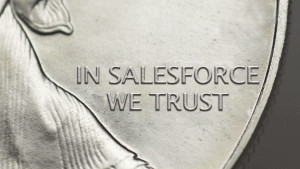- Bearson Smith
- Reading Time: 4 minutes

“In the world of these new connected products, in the Fourth Industrial Revolution, in this multi-stakeholder dialog that we have here, trust has to be the highest value in your company, and if it’s not, something bad is going to happen to you.”
– Marc Benioff co-CEO of Salesforce.com
Silicon Valley has been at the forefront of not only the Fourth Industrial Revolution, but also the corporate culture revolution. Many organizations started with the employee by building elaborate facilities that included amenities generally found in 5-star hotels. This generated a sense of culture and loyalty within corporations.
Today, IT vendors like Salesforce are ramping up their focus on culture and branding, but now through a different lens. Though they still use culture to drive loyalty internally within their company, Salesforce is also emphasizing it throughout their customer base as a way to build trust and strengthen their brand while putting themselves in the best position to drive revenue growth.
Trust Leads to Loyalty
In the past, customer loyalty was as simple as a company providing a great product or service that fulfilled a need or requirement. Over time, corporations attempted to increase loyalty and improve their brand through better customer service and partnership building within the customer base. Salesforce has taken this concept and magnified it tenfold, branding itself as a culture that revolves around care. Care for the employee, the customer, and the community. Through this branding exercise, Salesforce is quickly becoming a household name synonymous with trust.
Marc Benioff recently stated, “There is a clear connection between customer success and the company’s values and that’s why trust is the heart of our culture.” Salesforce has built a community through this culture and utilized it to expand their platform exponentially.
Take the Trailhead program as an example. As Benioff put it, Salesforce has built a “personal learning cloud that empowers everyone regardless of their background, to learn in-demand skills for free.” Salesforce wants all of its customers, most specifically the employees directly using the solution, to be as familiar with the platform as possible. They found the best way to accomplish such a task is by providing free training that benefits individuals needing to gain certifications to land a job or advance within the company they are currently working for. They also introduced a gamification element to further engage and motivate users to learn.
Salesforce knows this free training benefits their direct customers as it removes an expense for the customer. The customer does not have to provide training which not only costs money, but it pulls employees from their daily responsibilities. There is no doubt that Salesforce has helped organizations increase efficiency, resulting in millions of dollars of savings. All for free. They have done an amazing job, but they can do better.
Remember Salesforce’s Goal
Salesforce does genuinely care about their employees, their customers, and the community, but it is important to remember that they are still a publicly traded, for-profit business that needs to make money for investors. They are focused on trying to land-and-expand within their customer base by constantly pushing them toward adopting products tied to Salesforce’s Customer 360 platform. Salesforce’s acquisition of MuleSoft is an important aspect of this.
In their FY19 Q4 earnings call, Benioff stated, “With Mulesoft, we are now the number one integration platform.” Salesforce has an incredible amount of runway in terms of the Total Addressable Market (TAM) ahead of them. Mulesoft’s 2019 Connectivity Benchmark Report on the state of IT found that “while 97% of organizations are currently undertaking or planning to undertake digital transformation initiatives, integration challenges are hindering efforts for 84% of organizations.” Salesforce knows that they have positioned themselves well to not only motivate expansion but become the trustworthy and relied upon vendor for customers embarking on digital transformations.
The trust and culture that Salesforce promotes also empowers them to steer customers toward long term contracts. This increases remaining performance obligation and deferred revenue; metrics that Salesforce can look at for predictions regarding the company’s performance. Metrics such as these allow Salesforce to publicly announce that they will bring in between $26 and $28 billion in revenue by 2023 (~100% organic growth over 4 years after reporting $13.2B in revenue for FY19).
Beyond the trusted partnerships already in place, strong brand and reliance on current product offerings, Salesforce’s confidence in being able to reach such lofty goals stems from a few key reasons, all of which were discussed in the latest earnings call:
- Salesforce is #1 in the CRM application market with 20% overall CRM market share, which is more than the next three competitors combined
- The identified TAM for Salesforce products is around $142B
- One of the largest consulting firms indicated that 85% of their top 50 customers are just getting started on their digital transformation
- Automation is key for businesses now
- Salesforce has increased investment in Einstein products (now linking it to nearly every product that they offer) due to a broad rethinking of digital transformation based on a new level of automation that is available to executives.
Are Trust and Loyalty Enough?
Salesforce’s greatest success has been the level of loyalty and trust that they have built and branded themselves with. In the functional area they are operating in, their success depends on the success of their customers. And customers need to know that their IT vendor has their best interests in mind, too. However, it is still important to take a step back and make sure that the contractual language that both parties are signing reflects the trust and transparency that Salesforce is built on.
Related Blogs
SaaS Price Increases: What If Vendors Only Charged More When You Got More?
Salesforce Increasing Pricing and Adding Agentforce Options: What Customers Need to Know Now
Salesforce’s New Agentforce Pricing: What Customers Should Know
About the Author
